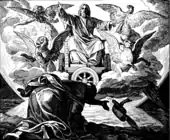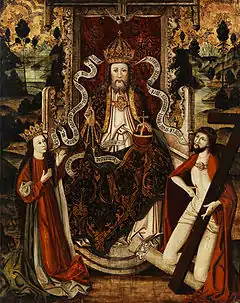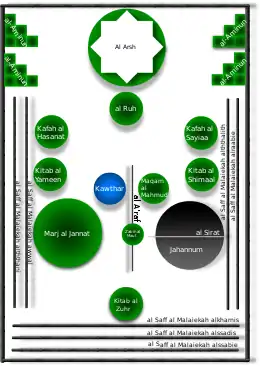Throne of God
The Throne of God is the reigning centre of God in the Abrahamic religions: primarily Judaism, Christianity, and Islam. The throne is said by various holy books to reside beyond the Seventh Heaven and is called Araboth (Hebrew: עֲרָבוֹת ‘ărāḇōṯ) in Judaism,[1] and al-'Arsh in Islam. Many in the Christian religion consider the ceremonial chair as symbolizing or representing an allegory of the holy Throne of God.
Judaism
Micaiah (1 Kings 22:19), Isaiah (Isaiah 6), Ezekiel (Ezekiel 1)[2] and Daniel (Daniel 7:9) all speak of God's throne although some philosophers, such as Saʿadiah Gaon and Maimonides, interpreted such mention of a "throne" as allegory.[3]
The heavenly throne room or throne room of God is a more detailed presentation of the throne, into the representation of throne room or divine court.
Micaiah's throneroom vision
Micaiah's extended prophecy (1 Kings 22:19) is the first detailed depiction of a heavenly throne room in Judaism.
Zechariah's throneroom vision
Zechariah 3 depicts a vision of the heavenly throne room where Satan and the Angel of the Lord contend over Joshua the High Priest in the time of his grandson Eliashib the High Priest. Many Christians consider this a literal event, others such as Goulder (1998) view the vision as symbolic of crisis on earth, such as opposition from Sanballat the Horonite.[4]
Dead Sea Scrolls
The concept of a heavenly throne occurs in three Dead Sea Scroll texts. Later speculation on the throne of God became a theme of Merkabah mysticism.[5]
Christianity


In the New Testament, the Throne of God is talked about in several forms.[6] Including Heaven as the Throne of God, The Throne of David, The Throne of Glory, The Throne of Grace and many more.[6] The New Testament continues Jewish identification of heaven itself as the "throne of God",[7] but also locates the throne of God as "in heaven" and having a secondary seat at the Right Hand of God for the Session of Christ.[8]
Revelation
The Book of Revelation describes the Seven Spirits of God which surround the throne, and John wishes his readers in the Seven Asian churches to be blessed with grace from God, from the seven who are before God's throne, and from Jesus Christ in Heaven. John states that in front of the throne there appears to be "a sea of glass, clear as crystal", and that the throne is surrounded by a lion, an ox, a man, and a flying eagle; each with six wings and covered with eyes, who constantly cry "Holy, holy, holy is the Lord God Almighty, who was, and is, and is to come" repeatedly. It is also said that "out of the throne proceeded lightnings and thunderings and voices".[9]
Isaiah In Isaiah 6, Isaiah sees the Lord sitting upon a throne, high and lifted up, and His train (robe) filled the temple. Above the throne stood the Seraphims (angelic beings), and each one had 6 wings. With two wings they covered their face, with two they covered their feet, and with two they flew. And the Seraphims were calling out to one another, "Holy, Holy, Holy, is the Lord of Hosts" (Some translations title Him, 'Lord of heavens armies', or 'Lord Almighty'). Their voices shook the temple to its foundations, and the entire building was filled with smoke.
Islam

In Islamic theology, the Throne (Arabic: العرش Al-ʿArsh) is one of the greatest things ever created by God.[11] Some Muslims including Salafis believe God created the throne both as a sign of his power and place of dwelling,[12][13][14] some Muslims including most of the Sufis believe it as a sign of his power and not as place of dwelling,[15] and some Including Ashari and Maturidi believe it as a metaphor of the greatness of God.[16][17][18]
The Quran mentions the throne some 25 times (33 times as Al-'Arsh), such as in verse 10:3 and 23:116:
Indeed, your Lord is Allah, who created the heavens and the earth in six days and then established Himself above the Throne (Arsh), arranging the matter [of His creation]. There is no intercessor except after His permission. That is Allah, your Lord, so worship Him. Then will you not remember? - Yunus 10:3
And it is He who created the heavens and the earth in six days - and His Throne had been upon water - that He might test you as to which of you is best in deed. But if you say, "Indeed, you are resurrected after death," those who disbelieve will surely say, "This is not but obvious magic." - Hud 11:7
So Exalted be Allah, the True King - None has the right to be worshipped but He - Lord of the Supreme Throne! - al-Mu’minoon 23:116
The Quran depicts the angels as carrying the throne of God and praising his glory, similar to Old Testament images.
...those who bear the Throne, and all who are round about it, sing the praises of their Lord and believe in Him and ask forgiveness for those who believe. - Quran 40:7
...and you shall see the angels going round about the Throne glorifying the praise of their Lord; and judgment shall be given between them with justice, and it shall be said: all praise is due to God, the Lord of the Worlds. - Quran 39:75
The Ayat al-Kursi (often glossed as "Verse of the footstool"), is a verse from Al-Baqara, the second sura of the Quran, and is regarded as the book's greatest verse. It references the Throne, and also God's greatest name, Al-Hayy Al-Qayyoom ("The Living, the Eternal").[19] Scholars of hadith have stated that Muhammad said the reward for reciting this verse after every prayer is Paradise,[20] and that reciting it is a protection from the devil.[21]
Prophetic hadith also establish that The Throne is above the roof of Al-Firdaus Al-'Ala, the highest level of Paradise where God's closest and most beloved servants in the hereafter shall dwell.[22]
See also
- Ayatul Kursi
- Hlidskjalf (throne of Odin)
- Kolob
- Origins and architecture of the Taj Mahal (section Concepts, symbolism and interpretations)
- Shesha - similar concept in Hinduism
Bibliography
- Notes
- In Seventh Heaven
-
 "Ezekiel 1:26" in the 1901 American Standard Bible.
"Ezekiel 1:26" in the 1901 American Standard Bible. - Bowker 2005, pp. Throne of God entry
- M. D. Goulder The Psalms of the return (book V, Psalms 107-150) 1998 p. 197 "The vision of Joshua and the Accuser in Zechariah 3 seems to be a reflection of such a crisis."
- Encyclopedia of the Dead Sea Scrolls: N-Z Lawrence H. Schiffman, James C. VanderKam - 2000 "References to heavenly thrones occur in three Dead Sea Scroll texts. In the Songs of the Sabbath Sacrifice ... Speculation on the throne of God and its associated creatures becomes an important aspect of Merkavah mysticism"
- Kittel 1966, pp. 164–166
- William Barclay The Gospel of Matthew: Chapters 11-28 p340 Matthew 23:22 "And whoever swears by heaven swears by the throne of God and by him who sits upon it."
- Philip Edgecumbe Hughes A Commentary on the Epistle to the Hebrews p401 1988 "The theme of Christ's heavenly session, announced here by the statement he sat down at the right hand of God, .. Hebrews 8:1 "we have such a high priest, one who is seated at the right hand of the throne of the Majesty in heaven")"
-
 "Revelations Chapter 4" in the New Testament.
"Revelations Chapter 4" in the New Testament. - Begley, Wayne E. The Garden of the Taj Mahal: A Case Study of Mughal Architectural Planning and Symbolism, in: Wescoat, James L.; Wolschke-Bulmahn, Joachim (1996). Mughal Gardens: Sources, Places, Representations, and Prospects Dumbarton Oaks, Washington D.C., ISBN 0884022358. pp. 229-231.
- Tafseer al-Qurtubi, 8/302, 303.
- Rifai, Sayyid Rami Al (2016). The Light Of Allah In The Heavens and The Earth: The Creation Of The Atom (24:35) and The Physics Of Spirituality. Sunnah Muakada.
- Elias, Jamal J. (1995). The Throne Carrier of God: The Life and Thought of 'Ala' ad-dawla as-Simnani. SUNY Press. ISBN 9780791426111.
- al-Din, Khwajah Kamal (1963). The Islamic Review. Woking Muslim Mission and Literary Trust.
- The Creed of Imam Al-Tahawi.
- Die Welt des Islams. D. Reimer. 2003.
- Shahrur, Muhammad (2009). The Qur'an, Morality and Critical Reason: The Essential Muhammad Shahrur. BRILL. ISBN 9789047424345.
- Yılmaz, Hakkı (14 June 2020). The Division By Division English Interpretation of THE NOBLE QUR'AN in The Order of Revelation. Hakkı Yılmaz. p. 566.
- Book 004, Number 1768: (Sahih Muslim).
- Sunnan Nasai'i al Kubra, (6/30), At-Tabarani; Al-Kabeer (8/114).
- Saheeh Al Bukhari - Volume 3, Book 38, Number 505.
- Saheeh al-Bukhaari (#2581).
- References
- Arnold, Edwin (1998). Pearls of the Faith (1998 ed.). Kessinger Publishing. ISBN 0-7661-0243-2. - Total pages: 340
- Bowker, John (2005). The concise Oxford dictionary of world religions (2005 ed.). Oxford University Press. ISBN 0-19-861053-X. - Total pages: 702
- Kittel, Gerhard (1966). Theological Dictionary of the New Testament, Volumes 3-4 (1966 ed.). Wm. B. Eerdmans Publishing. ISBN 0-8028-2245-2. - Total pages: 1116
- O'Shaughnessy, Thomas J. (December 1973). "God's Throne and the Biblical Symbolism of the Qur'ān". Numen. BRILL. 20 (3): 202–221. doi:10.1163/156852773x00376. JSTOR 3269642.
- Pickthalll, Marmaduke; Hanauer, James Edward (1935). Folk-lore of the Holy Land: Moslem, Christian and Jewish (1935 ed.). Forgotten Books. ISBN 1-60506-065-8. - Total pages: 280
External links
| Wikiversity has learning resources about Seven Heavens |